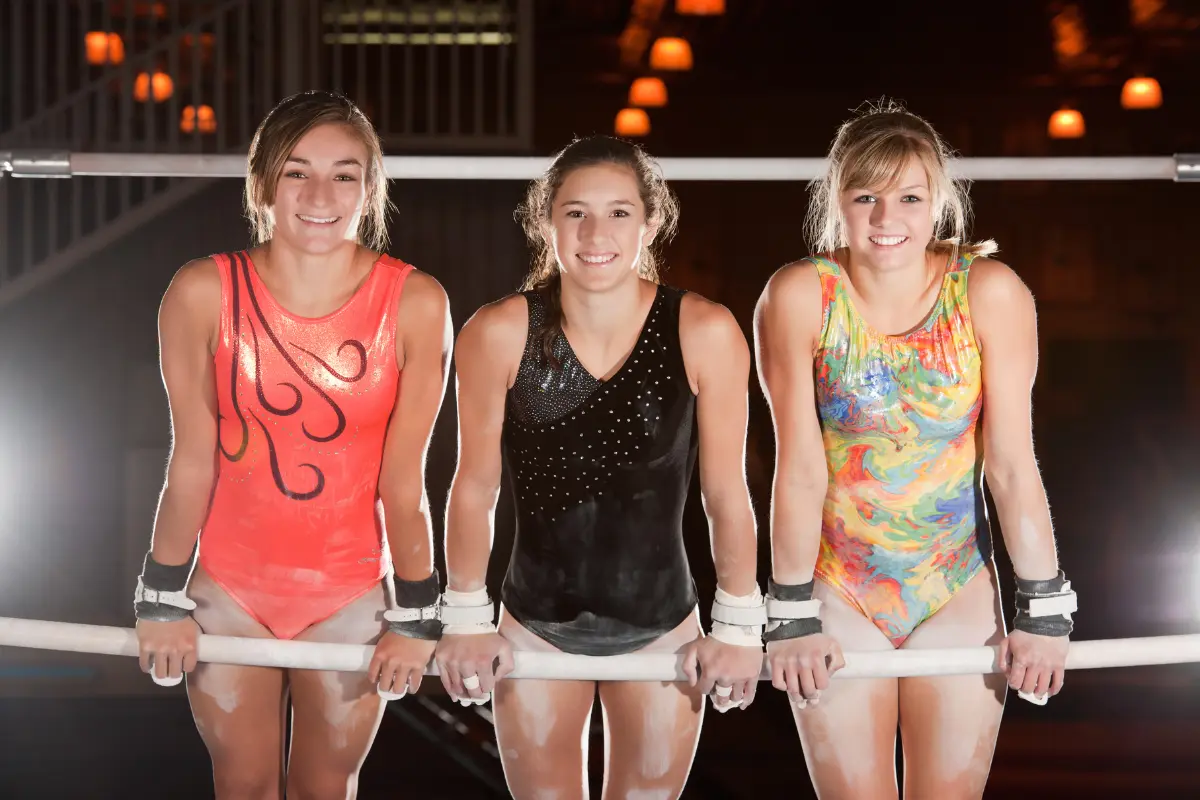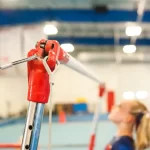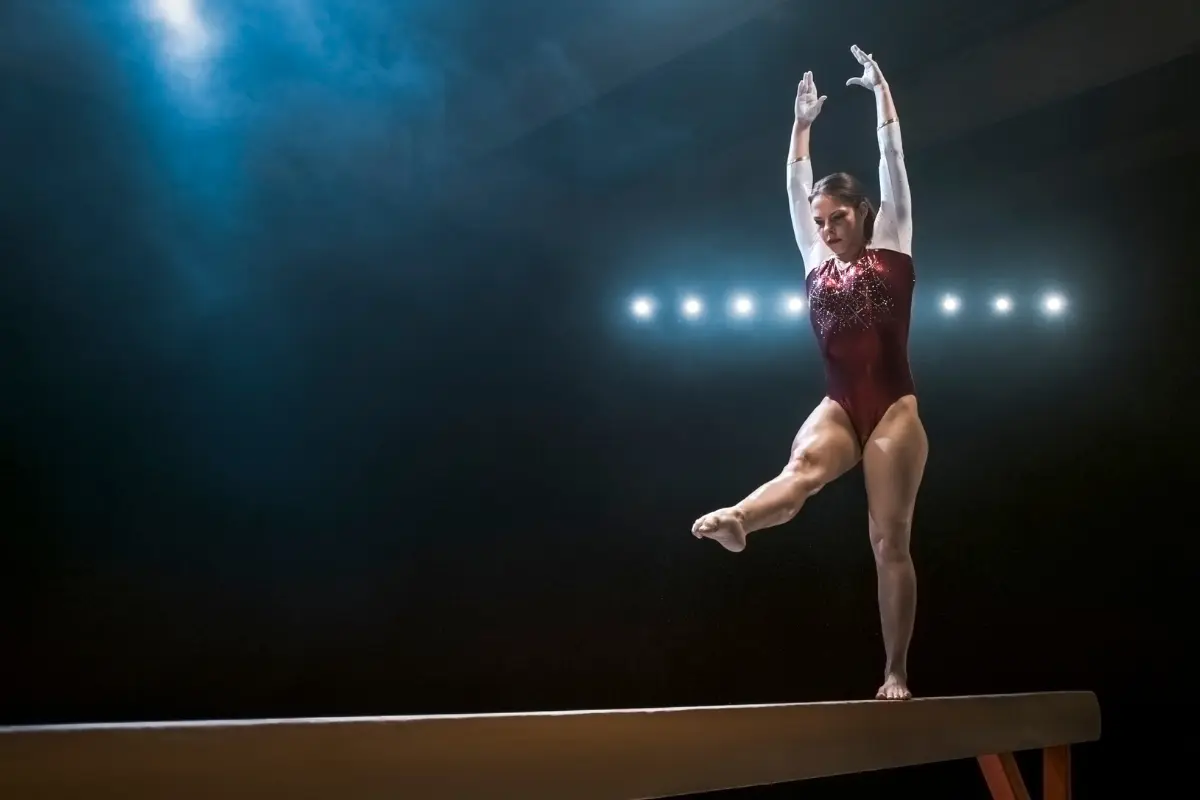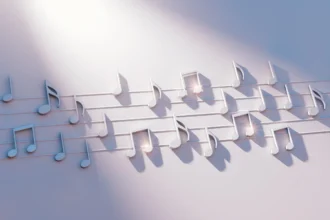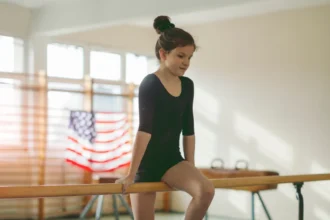Before gymnasts learn advanced skills like kips, flyaways, or giants, they must first master a solid foundation. These seven basic skills give young gymnasts the strength, body control, and confidence they need to progress safely.
- Mounts — Controlled Entry Onto the Bars
- Swings & Tap Swings — The Foundation of Bar Movement
- Casts — Lifting the Body Into Strong, Controlled Shapes
- Circles (Hip Circles) — Learning to Rotate Around the Bar
- Transitions — Moving Safely From the Low Bar to the High Bar
- Let-Go Drills & Basic Dismounts — Safe Air Awareness Training
- Body Awareness & Shaping — The Invisible Foundation
- Putting It All Together
Mounts — Controlled Entry Onto the Bars
What is a “mount”?
A “mount” is simply how the gymnast gets onto the bars to begin the routine. Even at the beginner level, mounts teach critical fundamentals: balance, grip strength, coordination, and body control. A clean, steady mount gives the gymnast confidence and sets the tone for the rest of the routine.
Beginner Mounts
Jump to Front Support (Low Bar)
A simple jump from the floor or springboard into a stable front-support position. This is often a gymnast’s first introduction to supporting their weight on the bar.
Single-Leg Squat On → Optional Jump to High Bar
The gymnast steps one foot onto the bar, brings the other leg up, and balances in a squat. Some gyms progress this into a small jump to the high bar when the gymnast is ready.
Pullover (Low Bar)
A beginner milestone where the gymnast lifts their legs over the bar from a hang and arrives in front-support. It builds strength and confidence.
Why Mounts Matter
- They teach safe entry and grip control
- They help gymnasts transition mentally from “floor” to “apparatus”
- They introduce body tension, straight arms, and proper posture
Swings & Tap Swings — The Foundation of Bar Movement
What are Bar Swings?
Swings are the core of bar gymnastics. They teach gymnasts how to move in a smooth, pendulum-like arc, build momentum, and maintain body shape throughout each phase of the swing.
A “tap swing,” sometimes referred to as “underswing–counterswing,” adds a deliberate shape change — hollow → arch → hollow — to generate power.
Beginner Swing Skills
Basic Forward/Backward Swings
These teach how to move smoothly under the bar, stay tight, and maintain straight arms.
Tap Swing (Underswing–Counterswing)
The gymnast changes body shapes (from hollow → arch → hollow) to generate momentum. This becomes crucial for higher-level swings, casts, and dismounts.
Why Swings Matter
- They improve shoulder strength and endurance
- They teach timing and rhythm
- They build the awareness needed for future giants and releases
- They prepare gymnasts to feel comfortable in motion on the bars
Casts — Lifting the Body Into Strong, Controlled Shapes
What is a Cast?
A cast is performed from a front support (or support position on the bar). The gymnast pushes down on the bar and uses shoulder, hip, and core strength to lift the body upward and slightly away from the bar, creating space and a better body line above the bar.
Beginner Cast Progression
Small Casts
The gymnast lifts their hips slightly off the bar, focusing on straight arms and tight body shapes.
Cast to Horizontal
A common standard in beginner levels where the gymnast reaches a straight, horizontal body line.
Why Casts Matter
- They teach correct shaping and body tension
- They build pressing strength
- They prepare gymnasts for hip circles and advanced casting skills
- They help set up other skills that require clearance from the bar
Circles (Hip Circles) — Learning to Rotate Around the Bar
What are Circles on Bars?
Circle skills involve rotating around the bar while maintaining consistent body shape and grip. For beginners, hip circles are often the first “circling” skill taught because they emphasize body control and timing rather than power or release.
Common Beginner Circles
Back Hip Circle
From front support, the gymnast casts slightly and rolls backward around the bar, returning to front support—one of the first “real” bar skills kids learn.
Front Hip Circle / Mill Circle
Depending on the gym, these may be taught early to help gymnasts understand forward rotation and balance in different shapes.
Why Circles Matter
- They teach rotational control
- They improve timing and body coordination
- They help gymnasts understand bar pressure and contact
- They prepare athletes for more advanced circles like clear-hips
Transitions — Moving Safely From the Low Bar to the High Bar
What are Transitions?
The uneven bars consist of two bars at different heights; transitions allow a gymnast to move from the low bar to the high bar (or vice versa) — a fundamental part of uneven-bars routines..
Beginner-Level Transitions
Squat-On → Jump to High Bar
A staple transition where the gymnast stands on the low bar and jumps to catch the high bar using good grip technique.
Glide or Basic Swing → Jump Transition
Some gyms use glide swings to teach timing and spacing before introducing the jump to the high bar.
Why Transitions Matter
- They build confidence with bar spacing
- They develop hand-eye coordination
- They prepare gymnasts for smooth routine flow
- They introduce the concept of “flight” in a safe, controlled way
Let-Go Drills & Basic Dismounts — Safe Air Awareness Training
Since true release moves like Tkatchevs or Pak saltos are far beyond beginner level, introductory bar training focuses on safe, simple let-go motions and early dismounts to help gymnasts learn how to release the bar with control.
Beginner-Appropriate Skills
Underswing Dismount (Low Bar)
The gymnast swings under the bar and releases into a controlled landing. This is one of the first true bar dismounts taught.
Controlled Jump-Off or Low Swing Release
Practiced with mats and supervision to build grip confidence and safe landings.
Why They Matter
- They teach landing mechanics and safety
- They build courage and awareness of movement through the air
- They prepare gymnasts for more advanced dismounts like flyaways
Body Awareness & Shaping — The Invisible Foundation
This final category isn’t a single skill but an essential set of physical concepts taught from day one. Before any difficult moves are introduced, gymnasts must learn how to hold their bodies correctly in space.
Beginner-Appropriate Skills
Underswing Dismount (Low Bar)
The gymnast swings under the bar and releases into a controlled landing. This is one of the first true bar dismounts taught.
Controlled Jump-Off or Low Swing Release
Practiced with mats and supervision to build grip confidence and safe landings.
Why They Matter
- They teach landing mechanics and safety
- They build courage and awareness of movement through the air
- They prepare gymnasts for more advanced dismounts like flyaways
Putting It All Together
A beginner uneven bars routine or practice session might include:
- A simple mount
- A few swings or tap swings
- Several small casts
- A back hip circle
- A transition like squat-on → jump to high bar
- A safe underswing dismount
- And throughout… strong shaping and tight form
Once these foundations are stable, gymnasts are ready to progress to more advanced skills like kips, higher casts, long-hang swings, and eventually giants and release moves.
